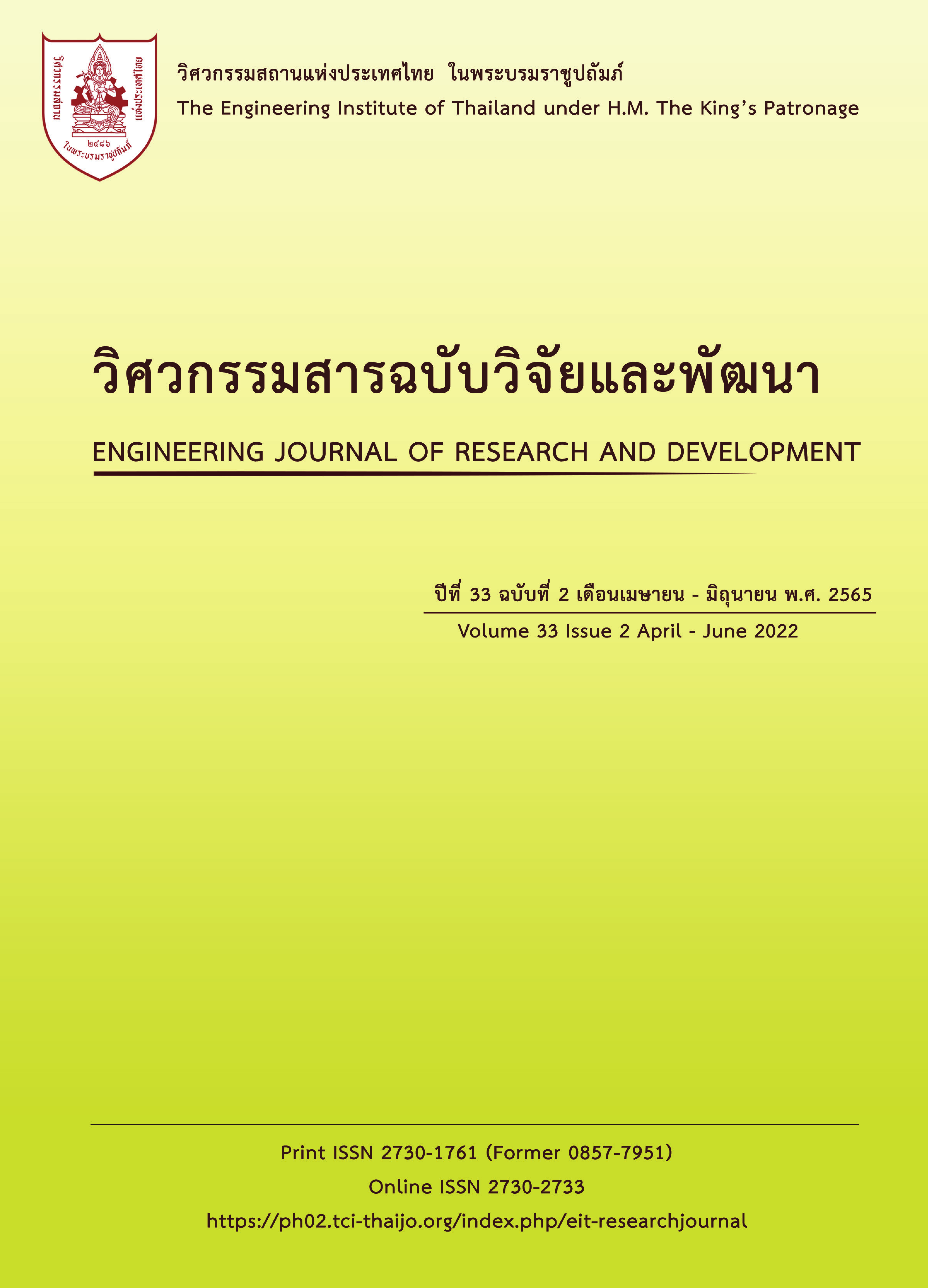คุณลักษณะของเถ้าขยะเทศบาลที่มีผลต่อสมบัติเชิงกลและการขยายตัวของมอร์ต้าร์ที่ผ่านการแช่ในโซเดียมซัลเฟต
Main Article Content
บทคัดย่อ
งานวิจัยนี้ศึกษาคุณลักษณะของเถ้าขยะเทศบาลที่มีผลต่อสมบัติเชิงกลและการขยายตัวของมอร์ต้าร์ที่ผ่านการแช่ในโซเดียมซัลเฟต โดยแทนที่ปูนซีเมนต์ไฮดรอลิกชนิดใช้งานทั่วไป (GU) และปูนซีเมนต์ปอร์ตแลนด์ประเภทที่ 1 (PC) ด้วยเถ้าขยะเทศบาล (MWA) บางส่วน ในอัตราส่วนร้อยละ 5 10 15 20 25 และ 30 โดยมวลของวัสดุประสาน พบว่า กำลังรับแรงอัดที่อายุการบ่ม 28 วัน
ของมอร์ต้าร์ GU ผสมเถ้าขยะเทศบาล มีค่ามากกว่ามอร์ต้าร์ PC ผสมเถ้าขยะเทศบาลทุกอัตราส่วน ยกเว้น GU-15MWA และมีค่าเพิ่มขึ้นตามลำดับ เมื่อร้อยละการแทนที่เท่ากับ 5 และ 10 จากนั้นมีค่าลดลงอย่างต่อเนื่อง โดยอัตราส่วน GU-10MWA มีกำลังรับแรงอัดได้สูงสุด 37.2 เมกะปาสคาล เนื่องจากอิทธิพลของการอัดตัวของอนุภาค (Packing effect) ในซีเมนต์เพสต์ ขณะที่กำลังรับแรงดัดของมอร์ต้าร์ GU มีค่าไม่แตกต่างกับมอร์ต้าร์ PC และลดลงเมื่อร้อยละการแทนที่ของเถ้าขยะเทศบาลเพิ่มขึ้น การขยายตัวของมอร์ต้าร์ GU และมอร์ต้าร์ PC มีค่าเพิ่มขึ้นตามร้อยละการแทนที่เถ้าขยะเทศบาลที่เพิ่มขึ้น โดยมอร์ต้าร์ GU มีค่าการขยายตัวน้อยกว่ามอร์ต้าร์ PC
Article Details

This work is licensed under a Creative Commons Attribution-NonCommercial-NoDerivatives 4.0 International License.
บทความที่ได้รับการตีพิมพ์เป็นลิขสิทธิ์ของวารสารวิศวกรรมสารฉบับวิจัยและพัฒนา วิศวกรรมสถานแห่งประเทศไทย ในพระบรมราชูปถัมภ์
References
Neusa, Ap. et.al. Alkali activated cement made from blast furnace slag generated by charcoal: Resistance to attack by sodium and magnesium sulfates. Construction and Building Materials, 2020, 238, pp. 1-8. DOI: 10.1016/j.conbuildmat.2019.117710.
Barbosa Costa, L.C. Sodium sulfate attack on portland cement structures: experimental and analytical approach. REM - International Engineering Journal, 2018, 71 (4), pp. 531-542. DOI: 10.1590/0370-44672018710009.
Gopalakrishnan, R. and Jeyalakshmi, R. The effects on durability and mechanical properties of multiple nano and micro additive OPC mortar exposed to combined chloride and sulfate attack. Materials Science in Semiconductor Processing, 2020, 106, pp. 1-14. DOI: 10.1016/j.mssp.2019.104772.
Chindaprasirt, P. and Jaturapitakkul, C. Cement Pozzolan and Concrete, 7th ed. Bangkok: Thailand Concrete Association, 2012.
Vattanakul, Y. et.al. Cementitious properties and expansion in sodium sulfate solution of concrete with fly ash and limestone powder. Journal of Engineering, RMUTT, 2012, pp. 51-59.
Kaolim, N. Durability of concrete made with industrial wastes. Master’s Thesis, Nakhon Nayok: Rajamangala University of Technology Thanyaburi, 2017.
Regional Environmental Office 16 (Songkhal). Report on the results of monitoring and evaluation of the wastewater collection and treatment system and the community solid waste disposal system. Regional Environmental Office 16, 2560.
Department of Alternative Energy Development and Efficiency. Knowledge enhancement in waste to energy management. Ministry of Energy, 2559.
Sanewu, I.F. et.al. Pozzolanic characteristics of municipal solid waste ash. Jomo Kenyatta University of Agriculture and Technology, 2013,
(1), pp.70-80.
Thai Industrial Standard. TIS 2594-2556: Hydraulic cement. Bangkok, 2556.
Thai Industrial Standard. TIS 15 1-2555 Portland Cement Part 1 Specification. Bangkok, 2547.
Chantaramanee, S. et.al. Properties of cement composite fabricated from white rice husk ash incorporated with short single-walled carbon nanotubes. Engineer Journal Chiang Mai University, 2018, 25 (3), pp.113-121.
Nagrockiene, D. et.al. The effect of waste from Mineral wool manufacturing on The properties of Concrete. Ceramics-Silikáty, 2021, 65 (2), pp.141-147. DOI: 10.13168/cs.2021.0013.
Thai Cement Manufacturers Association. Hydraulic Cement. Thai Cement Manufacturers Association. Bangkok, 2563.
Nguyen, T.B.T. et.al. Influences of different types of fly ash and confinement on performances of expansive mortars and concretes. Construction and Building Materials, 2019, 209, pp. 176-186. DOI: 10.1016/j.conbuildmat.2019.03.032.
Yang, J. et.al. Improving durability of heat-cured high volume fly ash cement mortar by wet-grinding activation. Construction and Building Materials, 2021, 289, pp. 1-13. DOI: 10.1016/j.conbuildmat.2021.123157.
Fanghui, H. et.al. The differences among the roles of ground fly ash in the paste, mortar and concrete. Construction and Building Materials, 2015, 93, pp. 172-179. DOI: 10.1016/j.conbuildmat.2015.05.117
Chindaprasirt, P. et.al. Utilization of fly ash and waste material from industrial factory as a material in concrete, 2th ed. Bangkok: King Mongkut's University of Technology Thonburi, 2553, pp.15-33.
Wang, C. et.al. Effect of binary admixture of sepiolite and fly ash on carbonation and chloride resistance of modified cement mortar. Construction and Building Materials, 2021, 279, pp. 1-13. DOI: 10.1016/j.conbuildmat.2021.122509.
Lima, C.P.F. et.al. Evaluation of corn straw ash as supplementary cementitious material: Effect of acid leaching on its pozzolanic activity. Cement, 2021, 4, pp. 1-12. DOI: 10.1016/j.cement.2021.100007.
Ngarmkham, S. Effects of municipal waste ash on the durability and mechanical properties of concrete. Master’s Thesis, Songkhla: Rajamangala University of Technology Srivijaya, 2016.
Sangrayab, A. Effect of fly ash type on properties of paste, mortar and concrete. Master’s Thesis, Nakhon Nayok: Rajamangala University of Technology Thanyaburi, 2017.
Chunran, W. et.al. Effects of high-calcium sepiolite on the rheological behaviour and Effects of high-calcium sepiolite on the rheological behaviour and. Construction and Building Materials, 2019, 196, pp. 105-114. DOI: 10.1016/j.conbuildmat.2018.11.130.
Jatuphon, T. et al. Packing effect and pozzolanic reaction of fly ash in mortar. Cement and Concrete Research, 2005, 35, pp. 1145-1151. DOI: 10.1016/j.cemconres.2004.09.030.
Khan, M.N.N. et al. Filler effect of pozzolanic materials on the strength and microstructure development of mortar. KSCE Journal of Civil Engineering, 2017, 21 (1), pp. 274-284. DOI: 10.1007/s12205-016-0737-5.
Chatveera, B. and Srinourn, P. A study of properties of mortar portland cement type V mixed with ground rice husk ash and limestone powder. KMUTT Research and Development Journal, 2012, 35 (2), pp.201-218.
Teixeira, E.R. et al. Quality and durability properties and life-cycle assessment of high volume biomass fly ash mortar. Construction and Building Materials, 2019, 197, pp. 195-207. DOI: 10.1016/j.conbuildmat.2018.11.173.
Hodhod, O.A. and Salama, G. Simulation of expansion in cement based materials subjected to external sulfate attack. Ain Shams Engineering Journal, 2014, 5, pp. 7-15. DOI: 10.1016/j.asej.2013.05.002.
Chusilp, N. et al. Effects of LOI of ground bagasse ash on the compressive strength and sulfate resistance of mortars. Construction and Building Materials, 2009, 23, pp.3523-3531. DOI: 10.1016/j.conbuildmat.2009.06.046.
Zahedi, M. et al. Properties and durability of concrete containing fluidized bed combustion (FBC) fly ash. Construction and Building Materials, 2020, 258, pp. 1-9. DOI: 10.1016/j.conbuildmat.2020.119663.

